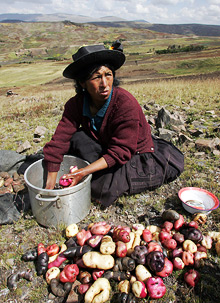Llamas and mash
Feb 28th 2008 - The Economist
 (left) AFP Tastier than frozen french fries
(left) AFP Tastier than frozen french fries
MENTION potatoes in the United States and most people immediately think of Idaho, where more than a quarter of the country's crop is produced. In Europe, Ireland and its famine or Poland and its vodkas come to mind. But nowhere is prouder of its potatoes than Peru, where they were domesticated more than 7,000 years ago. The country is home to up to 3,500 different varieties of edible tubers, according to the International Potato Centre, whose headquarters are near Lima.
The United Nations has designated 2008 as the “International Year of the Potato” and not surprisingly Peru hopes to use this to draw attention to itself and its crop. Alan García, the president, has ordered that a government-sponsored programme of free breakfasts for poor families should serve bread made from a mixture of potato flour with (expensive and mainly imported) wheat. He also wants barracks, hospitals and prisons to start serving chuño, a naturally freeze-dried potato that is traditionally eaten by Andean Indians. Boiled chuño and cheese are said to have replaced sandwiches at cabinet meetings.
The government has joined forces with the potato centre to organise an international roadshow to promote the spud, starting this month. Apart from a giant foam-rubber model of a potato, the roadshow will include demonstrations of recipes by leading chefs.
But perhaps the propaganda should start at home. Many Peruvians eat more rice than potatoes; the country even imports frozen chips for use in fast-food restaurants. Only 25 varieties are grown commercially in Peru. Domestic consumption of spuds is about 90 kilos (200lb) per head a year, according to Ismael Benavides, the agriculture minister. That is barely a quarter as much as Belarusians, the world's champion potato-eaters, manage to chomp through. Nowadays Peru produces only 3.3m tonnes a year, or barely 1% of world output. “Peru needs to re-identify with the potato, because we have turned our back on it for too long,” says Mr García.
Peru's farm exports totalled $2.2 billion last year, including asparagus, paprika and artichokes. Most of these crops are grown on the fertile Pacific coast. But potato exports amount to just $500,000. Officials hope that paying more attention to spuds could help some of the poorest Peruvians. Ordinary white potatoes are grown on the coast. But more unusual—and tastier—varieties survive in the Andean highlands. Peruvian yellow potatoes are prized by gourmets for mashing; tubular ollucos are firm and waxy. As Peru's rich cuisine becomes better known abroad, demand for these tubers could grow, reckons Luis Carranza, the economy minister.
Some farmers plan to export white potatoes to Brazil. To export yellow potatoes, farmers need to deal with bugs and fungal diseases, and to produce on a larger scale. Mr García wants to see processing plants in the highlands that would turn out potato starch and powder. The government has plans to draw up a registry of some 30 varieties for which it would fix a denomination of origin.
Whether that is the best way to promote potato exports is debatable. In Cutervo, the centre of a big potato-growing region in the northern highlands, farmers have yet to find a way to turn potatoes into prosperity. The European Union is paying for a pilot processing-plant in the town. But the mayor, Wilson Delgado, complains that prices for the crop are low, while those for fertilisers are rising. He worries that Peru's recently approved free-trade agreement with the United States will lead to a flood of subsidised imports. That fear is probably exaggerated. But it is certainly time for Peru to make more of its potato patrimony.